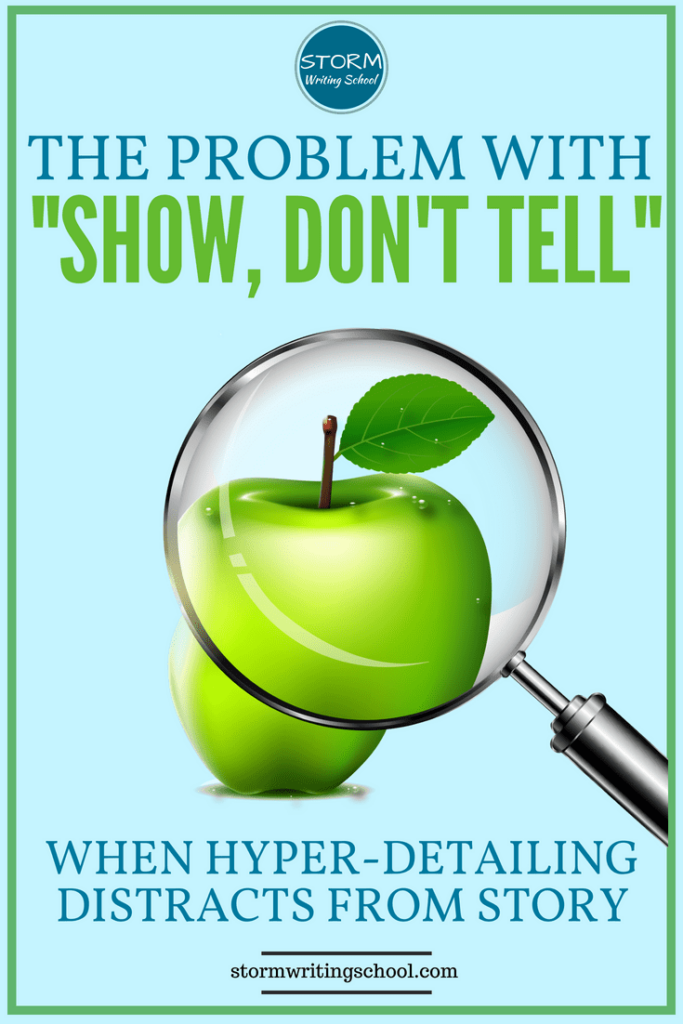The old writing adage of “show, don’t tell” is good advice, but it can occasionally get writers in trouble.

The Value and Purpose of Showing
Let me quickly explain what’s good and right about showing, as I see it. Readers enjoy inferring subtext and motivation and mood and significance. When you tell them that stuff, it robs them of the chance to do something they love doing.
If you want the reader’s attention and devotion, you need to provide something that allows her to read between the lines. In other words, you want to simulate actual experience. Which means you don’t tell us that Angie was angry. You show us what we would see if we were in the room with Angie. (Or if we were Angie.)
Even if stories are speculative and fantastical, we pretty much want them to simulate aspects of authentic, real life. That is, we want to consume an alternate reality in the same way we consume the reality we inhabit—by experiencing it.
Some writers understand showing to mean that the job of writers is to do his best to put the reader in the world of the story, to see it all as clearly as the writer does.
But that’s not the writer’s job.
No, the writer’s job is to get readers to identify with the experience of a character (or characters). And if we’re to mimic real-life experience in our stories, we need to be sure not to convey everything. After all, we don’t percieve everything around us in the real world; the characters in our stories shouldn’t perceive everything either.
Hyperdetailing
I certainly see lots of writing that fails to show enough concrete, physical detail. But I also see lots of manuscripts that err on the side of excessive showing. I call it “hyperdetailing,” and it occurs when writers “show” the wrong things.
What do I mean by wrong?
I mean irrelevant detail. I mean descriptions that are not significant and are thus boring for the reader.
Consider the various ways in which you might narrate a trip to the grocery store. You may begin with a simple, “I went to the store.”
Or you could specify a little: “I drove to the grocery store yesterday.”
Or you could really try to “show”: “I opened the door to my ailing, late-90s Toyota Sienna, noting the chipped burgudy paint on the fenders just above the wheel wells. I sat on the crusty leather seats, burning from the day’s heat, which weighed heavy in the humid air already at 10:00 am. Turning the key in the ignition, I listened to the old beast cough to life. The fan belt screeched for a full minute as I backed the van out of my driveway and headed south on Park Street toward the Pick N Save next to the old labor temple.”
If this is to be a story about what happened at the grocery store, how many details do we need about the car and route that got you there?
Kinds of Hyperdetailing
I’ve come to recognize four kinds of hyperdetailing, but I don’t often label them when I comment on manuscripts. It’s just that knowing the potential places you might find yourself hyperdetailing may get you looking in the right neighborhoods for this problem.
(And I want to be clear, by the way, that this problem is mostly one I see in very competent writing. Showing is a skill that comes with experience. And it’s probably the most oft-complimented craft accomplishment I see writers give one another when I run workshops and critique groups.
That is, writers get a lot of positive reinforcement for their ability to show. And that may be part of the problem.)
Characterization
I land solidly in the camp of minimal character description. Readers will form ideas in their heads about characters, mostly based on character behavior. If you do describe characters, chances are readers will entirely miss those descriptions anyway. Remember all those people who missed that Rue from Hunger Games was dark skinned? And did you know that Jordan Baker from The Great Gatsby was a blonde?
Now, there are certain genres in which physical appearance is pretty important, most notably romance. But in such cases, physical descriptions are appropriate because they have so much to do with character desire, which drives the whole story.
Other stories use physical description to great effect–like Children of Blood and Bone, in which physical appearance often has to do with conflict; white-haired diviners are discriminated against and seen as a threat to the kingdom.
It’s the gratuitous, paragraph-long descriptions of characters that rankle me.
Make description relevant to desire or conflict and you’re in business. Otherwise, you might be hyperdetailing.
Info Dumps
I get it; we writers really like our imagined or remembered worlds. And we also like doing research about those worlds. So it’s really tempting to compose eloquent passages about salt-water exotic fish aquariums or the civil-war era paper mill your protagonist worked at as a teenager.
And you know what? Go ahead and write all about that stuff.
Just be sure to cut as much of it as you can in your final draft.
(For more on incorporating information, see this article.)
Setting
Descriptions of place and “set” do a lot for the mood of the scene and can definitely help create a world that readers enjoy visiting. Setting is a key for vicarious experience. So I’m not saying that you should eradicate descriptions of place by any means. (Nor am I saying that all information and characterization are unnecessary.)
But if you’re using a full page to describe the British countryside in your historical novel or if you’re cataloguing booths at the marketplace in your high fantasy novel, chances are good I’d flag those passages in my edit of your work and ask if they’re important to the current scene.
And yes, they need to be important to the current scene, not to some scene 50 pages from now. Later importance does not justify the inclusion of a long descriptive passage.
Clumsy Interiority
How can interiority be shown? The most common method you’ll see promoted is through physical signifiers. Don’t tell us someone is sad; show us how they hang their head, cry, mope, etc.
It’s well-meaning advice, but it leads right into cliché land. Because how many external signifiers are there for emotions anyway? Writers tend to fall back on the same old stuff in first drafts at least: hearts racing, palms sweating, knees wobbling, jaws hanging open, brows furrowed, etc. That kind of showing is going to get you in trouble because it will feel like a poorly acted film.
So what should you do? Well, if you want to go with physical signifiers, try to make them relatively idiosyncratic. But there are other methods: sometimes you can show interiory via a flashback or via speculation about the future. Flashes to the past and future can remain vivid (showing) as they relay a character’s state of mind.
But sometimes interiority just needs to be explained. It’s okay to tell it, especially when it’s complex.
Still, I do see people go overboard with all of these more advanced methods of conveying interiority: excessive flashbacks, overly-long imaginative riffs, and, ironically, too much telling the reader about a character’s internal processes.
(For more on interiority, by the way, check out these two articles: Lessons from “Cat Person” & Juggle External Action and Interiority.)
The Bottom Line
Showing is an incredibly important skill for a writer to cultivate. In fact, “show, don’t tell” is probably the most important part of “good writing.” But if you’re telling a story, the imperatives of storytelling trump the imperatives of good writing every time. Or, put another way, writing must serve the storytelling, and the problem with “show, don’t tell” is that it sometimes rips readers away from the story.
So take a look at your writing to see whether it may succumb to any of these hyperdetailing pitfalls. If it does, you’ve got a pretty good problem on your hands. All you need to do is cut.
Other troubleshooting articles:
- 12 Ways to Be an Invisible Writer
- 4 Failures in Story Cause/Effect
- Common Problems in Manuscripts
- Why the Hero’s Journey May Not Be Right for Your Story
This article is part of the Author Toolbox Blog Hop. To continue hopping through other great blogs in the monthly hop or to join, click here and/or search #AuthorToolboxBlogHop on Twitter and Pinterest (here’s the group board).








25 Responses
Great post. I hate hyperdetailing. Usually when I come across it in a story, I tend to skip over it until the action starts.
Exactly. Anything a reader skips should be axed from the story!
You make so many good points here 🙂
I switch off and skip paragraphs with too much irrelevant description, so I can get to the point, and I tend to under-describe when I write. I prefer to drop in little hints of description as part of the action, rather than dedicate whole paragraphs to it. I could probably do with describing setting a little more, but particularly in a first draft I prefer to gloss over it, and add description later if I think it’s relevant to the story.
Yeah, I tend to under-describe in first drafts, too. But personally, I’d rather have my beta readers asking for a clearer sense of setting than telling me they weren’t engaged.
Great post! Hyperdetailing is definitely something I’ve struggled with in the past. Especially when I’m in NaNoWriMo mode and I’m just trying to reach a word count, hyperdetailing was the way I did it. At some point I tried to go in the opposite direction, getting the barest details in a story to get absolutely no extraneous words, but that led to a really dry style that was even harder to edit that the hyerdetailed stories! I think now I’ve struck a decent balance, but it’s all in the editing, re-reading stories and making choices on what stays and what goes. Thanks for sharing!
Haha! NaNoWriMo word counts can be counter-productive sometimes. I agree, though, that we all have our tendencies in initial drafts and in many cases, we don’t need to fight against those tendencies so long as we can put faith in editing.
I definitely am hyper-aware of my tendency to show and NEVER tell. The only place where it gets me into trouble, though, is interiority. That’s one of the major things I’m focusing on in my current revision: making sure there aren’t a lot of cliched character beats/reactions.
I know! Interiority is tricky!
I like your examples on showing and telling. I agree, it is a skill writers learn along the way. Excellent post 🙂
Thanks, Erika!
This is a fantastic post that many authors could benefit from reading. I remember the first time I read the advice, Show Don’t Tell, but it wasn’t enough for me to understand this. I’d like to reblog this later in the week if you don’t mind.
Thanks, Kristina! Yes, please do reblog!
Hyperdetailing. I like that word – it’s a great description of excessive description. I’ve just done a sample edit on a first chapter which is full of great showing, but in which nothing happens (well, nothing that’s relevant to the plot. I hope the plot isn’t going to be bickering siblings). I think it scores 3 out of 4 in your list!
Good post. Too often in writing advice “Show, Don’t Tell” is presented as an absolute.
Also picked up some new words: hyper-detailing and interiority (hey, the spelling checker wants me to change the first t to an f, but interiority is listed in my 1964 Webster’s).
Confession time: I enjoyed the Toyota Sienna paragraph…I was imagining the vehicle belonging to a bottom-feeding detective.
Yeah, my spellchecker doesn’t like interiority either, but it’s wrong. 🙂
The Toyota Sienna paragraph was fun to write.
I jump ship, so to speak, when the descriptions are longer than a paragraph. If I like a writer and they go all purple prose on me, I put the work down. don’t come back. When I write, I do it as if I’m going to read it. ‘Nuff said.
Sorry I’m late.
Anna from elements of emaginette
Write like you’ll read it. Good approach. The most difficult time to read like a reader, not a writer, is with your own work, though, right?
I think what you’re saying is a great example of how few things are really absolute. “Show” and “tell” are both useful tools in a writer’s toolbox, and they both have their place. There’s a basic truth that “looking at” or “focusing on one thing” causes other things to become blurred, more distant, and eventually fade away.
No story can cover everything, and it’s in the choice of what to show and what to tell/summarize/skip that meaning is established.
Every time I hear “Show, don’t tell” I think “show and tell”, not unlike the harmony found in most pieces of music. Each instrument plays its part, but few play continuously from start to finish.
I agree! You have a wonderful analogy there to music.